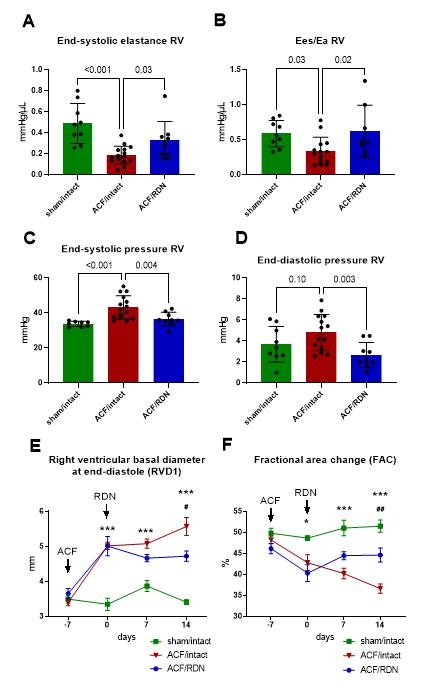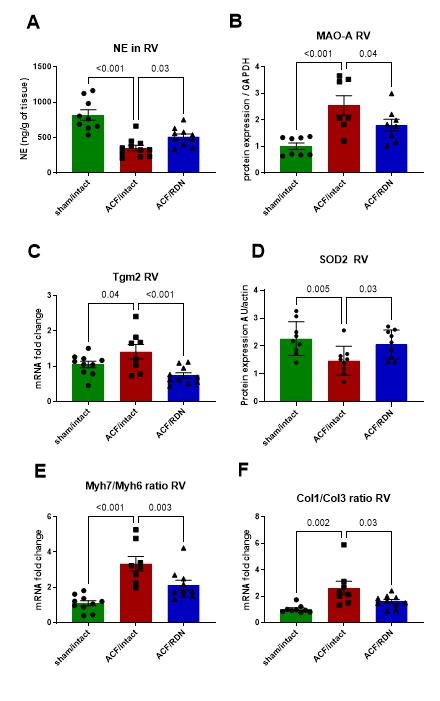Final ID: Tu057
Renal denervation enhances right ventricular function, reduces myocardial damage, and restores myocardial sympathetic signaling in rats with heart failure induced by volume overload
Abstract Body: Introduction Heart failure (HF) is associated with chronically increased sympathetic nervous activity with depleted norepinephrine (NE) in the myocardium. Despite the known anti-hypertensive effect of renal denervation (RDN), its influence on the function of the right ventricle (RV) and the cardiac sympathetic nervous system in HF is not well comprehended.
Hypothesis RDN improves RV function by reducing central sympathetic drive and changes of a sympathetic nervous branch in the heart.
Aims To investigate the effect of RDN on RV function, HF markers, myocardial NE, and its metabolism in RV in HF induced by aorto-caval fistula (ACF).
Methods HF was induced by ACF in Ren-2 transgenic rats (TGR). One week later, the RDN was performed by phenol application. Two weeks after RDN, RV function was measured by pressure-volume analysis and RV tissue was collected. Echocardiography was done once a week, during the entire experiment. NE levels were measured using an ELISA kit, protein expression was assessed by western blotting, gene expression by TaqMan PCR gene expression assay, and ROS by oxidation of Amplex Red assay.
Results The ACF increased RV weight, RV dimensions (RVD1, RVD2, RVD3), end-systolic (ESP) and end-diastolic pressure (EDP), reduced RV systolic function (end-systolic elastance - Ees, fractional area change - FAC) and ventricular-arterial coupling (Ees/Ea ratio), increased gene expression of HF markers collagen I/III ratio, natriuretic peptide A (Nppa), myosine heavy chain 7/6 (Myh7/6) ratio, transglutaminase 2 (Tgm2), and decreased superoxide dismutase 2 (SOD2) protein expression. ACF increased plasmatic NE levels, depleted NE in RV, decreased tyrosine hydroxylase protein expression in RV, and increased gene, protein expression, and activity of monoamine oxidase A (MAO-A).
RDN decreased RV hypertrophy and dilatation (RVD1, RVD2, RVD3), decreased RV ESP (-7 mmHg, p=0.004) and EDP (-2.2 mmHg, p=0.003), improved RV function (Ees +45%, p=0.03, FAC +20%, p=0.005, Ees/Ea ratio +46%, p=0.02), decreased HF markers collagen I/III ratio, Nppa, Tgm2, Myh7/6 ratio, and increased SOD2 protein expression. RDN decreased plasmatic NE levels, increased NE in RV (+32%, p=0.03), and decreased MAO-A in RV.
Conclusions RDN decreased RV ESP and EDP, improved RV systolic function, restored NE levels, and decreased RV gene expression of selected HF markers, probably by reduction of central sympathetic nerve drive and alterations of the cardiac sympathetic nervous system.
Hypothesis RDN improves RV function by reducing central sympathetic drive and changes of a sympathetic nervous branch in the heart.
Aims To investigate the effect of RDN on RV function, HF markers, myocardial NE, and its metabolism in RV in HF induced by aorto-caval fistula (ACF).
Methods HF was induced by ACF in Ren-2 transgenic rats (TGR). One week later, the RDN was performed by phenol application. Two weeks after RDN, RV function was measured by pressure-volume analysis and RV tissue was collected. Echocardiography was done once a week, during the entire experiment. NE levels were measured using an ELISA kit, protein expression was assessed by western blotting, gene expression by TaqMan PCR gene expression assay, and ROS by oxidation of Amplex Red assay.
Results The ACF increased RV weight, RV dimensions (RVD1, RVD2, RVD3), end-systolic (ESP) and end-diastolic pressure (EDP), reduced RV systolic function (end-systolic elastance - Ees, fractional area change - FAC) and ventricular-arterial coupling (Ees/Ea ratio), increased gene expression of HF markers collagen I/III ratio, natriuretic peptide A (Nppa), myosine heavy chain 7/6 (Myh7/6) ratio, transglutaminase 2 (Tgm2), and decreased superoxide dismutase 2 (SOD2) protein expression. ACF increased plasmatic NE levels, depleted NE in RV, decreased tyrosine hydroxylase protein expression in RV, and increased gene, protein expression, and activity of monoamine oxidase A (MAO-A).
RDN decreased RV hypertrophy and dilatation (RVD1, RVD2, RVD3), decreased RV ESP (-7 mmHg, p=0.004) and EDP (-2.2 mmHg, p=0.003), improved RV function (Ees +45%, p=0.03, FAC +20%, p=0.005, Ees/Ea ratio +46%, p=0.02), decreased HF markers collagen I/III ratio, Nppa, Tgm2, Myh7/6 ratio, and increased SOD2 protein expression. RDN decreased plasmatic NE levels, increased NE in RV (+32%, p=0.03), and decreased MAO-A in RV.
Conclusions RDN decreased RV ESP and EDP, improved RV systolic function, restored NE levels, and decreased RV gene expression of selected HF markers, probably by reduction of central sympathetic nerve drive and alterations of the cardiac sympathetic nervous system.
More abstracts on this topic:
Establishing functional benchmarks and pharmacological readiness of Mantarray-Engineered Heart Tissues across multiple hiPSC-derived cardiomyocyte lines
Arefin Ayesha, Kabi Neda, Gees Katharina, Kernan Kelly, Sullivan Ellie, Luttrell Shawn, Worthen Christal, Luerman Greg, Geisse Nicholas
Estrogen receptor alpha inhibits right ventricle cardiomyocyte NLRP3 inflammasome activation and restores right ventricular contractile function in low estrogen statesSobrano Fais Rafael, Givens Sophie, Bourgeois Alice, Woodcock Chen-shan, Petrache Irina, Woulfe Kc, Pullamsetti Soni Savai, Boucherat Olivier, Provencher Steeve, Ogle Brenda, Bonnet Sebastien, Das Neves Palotta Erica, Lahm Tim, Kopf Katrina, Mora Massad Karina, Neto Neves Evandro, Hoffer Christopher, Walts Avram, Frump Andrea, Goldenberg Neil


